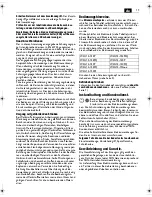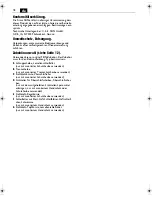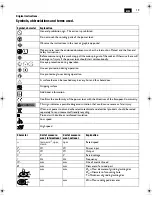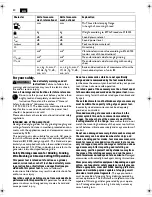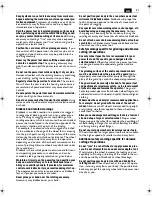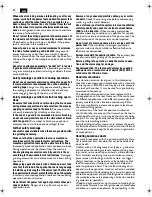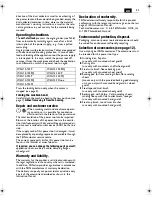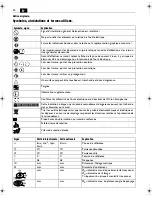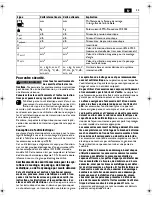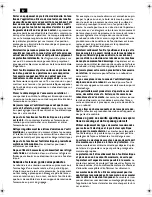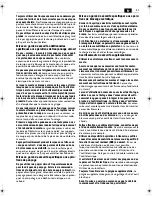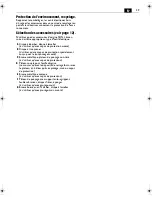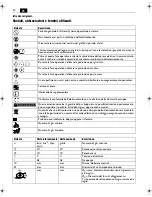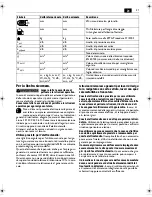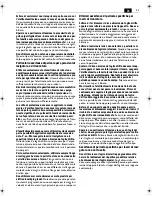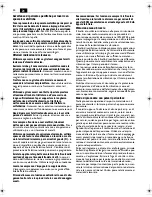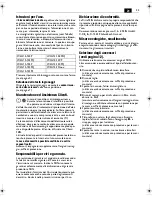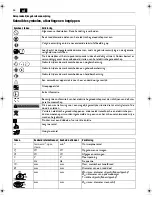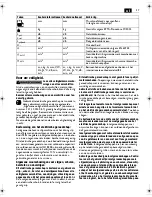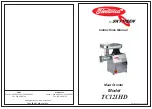
22
en
When wheel is binding or when interrupting a cut for any
reason, switch off the power tool and hold the power tool
motionless until the wheel comes to a complete stop.
Never attempt to remove the cut-off wheel from the cut
while the wheel is in motion otherwise kickback may
occur.
Investigate and take corrective action to eliminate
the cause of wheel binding.
Do not restart the cutting operation in the workpiece. Let
the wheel reach full speed and carefully re-enter the cut.
The wheel may bind, walk up or kickback if the power
tool is restarted in the workpiece.
Support panels or any oversized workpiece to minimize
the risk of wheel pinching and kickback.
Large work-
pieces tend to sag under their own weight. Supports
must be placed under the workpiece near the line of cut
and near the edge of the workpiece on both sides of the
wheel.
Use extra caution when making a “pocket cut” into exist-
ing walls or other blind areas.
The protruding wheel may
cut gas or water pipes, electrical wiring or objects that can
cause kickback.
Safety warnings specific for sanding operations
Do not use excessively oversized sanding disc paper. Fol-
low manufacturers recommendations, when selecting
sanding paper.
Larger sanding paper extending beyond
the sanding pad presents a laceration hazard and may
cause snagging, tearing of the disc, or kickback.
Safety warnings specific for wire brushing opera-
tions
Be aware that wire bristles are thrown by the brush even
during ordinary operation. Do not overstress the wires by
applying excessive load to the brush.
The wire bristles
can easily penetrate light clothing and/or skin.
If the use of a guard is recommended for wire brushing,
do not allow any interference of the wire wheel or brush
with the guard.
Wire wheel or brush may expand in
diameter due to work load and centrifugal forces.
Further safety warnings
Use elastic spacers/liners when these are provided with
the grinding accessory.
Make sure that the application tools are mounted in
accordance with the manufacturers instructions. The
mounted application tools must be able to rotate freely.
Incorrectly mounted application tools can become loose
during operation and be thrown from the machine.
Handle grinding accessories carefully and store them
according to the manufacturer’s instructions.
Damaged
grinding accessories can develop cracks and burst during
operation.
When using application tools with a threaded insert, take
care that the thread in the application tool is long enough
to hold the spindle length of the power tool. The thread in
the application tool must match the thread on the spindle.
Incorrectly mounted application tools can loosen during
operation and cause injuries.
Do not direct the power tool against yourself, other per-
sons or animals.
Danger of injury from sharp or hot
application tools.
Beware of any concealed electric cables, gas or water
conduits.
Check the working area before commencing
work, e.g. with a metal detector.
Use a stationary extraction system, blow out ventilation
slots frequently and connect a residual current device
(RCD) on the line side.
When working metal under
extreme operating conditions, it is possible for conduc-
tive dust to settle in the interior of the power tool. The
total insulation of the power tool can be impaired.
Do not rivet or screw any name-plates or signs onto the
power tool.
If the insulation is damaged, protection
against an electric shock will be ineffective. Adhesive
labels are recommended.
Always work with the auxiliary handle.
The auxiliary han-
dle ensures reliable guiding of the power tool.
Before putting into operation, check the mains connec-
tion and the mains plug for damage.
Recommendation: The tool should always be supplied
with power via a residual current device (RCD) with a
rated current of 30 mA or less.
Hand/arm vibrations
The vibration emission level given in this information
sheet has been measured in accordance with a standard-
ised test given in EN 60745 and may be used to compare
one tool with another. It may be used for a preliminary
assessment of exposure.
The declared vibration emission level represents the
main applications of the tool. However, if the tool is used
for different applications, with different accessories or
poorly maintained, the vibration emission may differ.
This may significantly increase the exposure level over
the total working period.
An estimation of the level of exposure to vibration
should also take into account the times when the tool is
switched off or when it is running but not actually doing
the job. This may significantly reduce the exposure level
over the total working period.
Identify additional safety measures to protect the opera-
tor from the effects of vibration such as: maintain the tool
and the accessories, keep the hands warm, organisation
of work patterns.
Handling hazardous dusts
For work procedures with this power tool where mate-
rial is removed, dusts develop that can be hazardous to
one’s health.
Contact with or inhaling some dust types, e. g. asbestos
and asbestos-containing materials, lead-containing coat-
ings, metal, some wood types, minerals, silicate particles
from materials containing stone, paint solvents, wood
preservatives, antifouling paints for vessels, can trigger
allergic reactions to the operator or bystanders and/or
lead to respiratory infections, cancer, birth defects or
other reproductive harm. The risk from inhaling dusts
depends on the exposition. Use dust extraction matched
appropriately for the developing dust, as well as personal
protective equipment and provide for good ventilation of
the workplace. Leave the processing of asbestos-contain-
ing materials to specialists.
Wood and light-metal dust, hot mixtures of sanding dust
and chemical materials can self-ignite under unfavourable
conditions or cause an explosion. Avoid sparking in the
OBJ_BUCH-0000000123-002.book Page 22 Tuesday, August 13, 2013 9:40 AM
Summary of Contents for WSG8-115
Page 3: ...3 5 6 7 4 8 10 7 4 8 9 11 WSG15 70Inox...
Page 4: ...4 2 1 2 3 1...
Page 7: ...7 0 mm 2 1 3 1 2 4x 180 3...
Page 9: ...9...
Page 10: ...10...
Page 12: ...12 D E F G A B C...
Page 54: ...54 el el n min min 1 rpm r min min 1 P1 W W P2 W W U V V f Hz Hz M mm mm mm mm mm mm D H T...
Page 56: ...56 el H...
Page 57: ...57 el...










